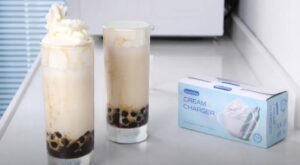
Where to buy Cream Chargers: A Comprehensive Guide
For most of us, whipped cream desserts fall somewhere between a daily necessity and a daily pleasure. And if you are reading this, then you
Cream chargers, small cylindrical devices filled with nitrous oxide, have revolutionized the culinary world, especially when it comes to creating fluffy whipped cream in a jiffy. But like many popular items, they’ve garnered a plethora of nicknames over the years, some of which hint at their primary use, while others dive into the more playful or underground aspects of their reputation. This article aims to explore the various monikers these chargers have acquired, delving into their origins and the stories behind them. Whether you know them as “whip-its” or “hippy crack,” there’s no denying the widespread influence and intrigue surrounding these little canisters.
The story of cream chargers is deeply intertwined with the history of nitrous oxide itself. Discovered in 1772 by English natural philosopher and chemist Joseph Priestley, nitrous oxide was initially explored for its potential medical applications. Sir Humphry Davy, another English chemist, was among the first to document the euphoric effects of inhaling the gas, leading to its colloquial name, “laughing gas.”
By the late 18th and early 19th centuries, nitrous oxide found its way into various entertainment venues, with “laughing gas parties” becoming a unique form of amusement. However, it wasn’t until the 20th century that the culinary potential of nitrous oxide was recognized. The gas’s ability to whip cream quickly and efficiently led to the development of the modern cream charger.
As cream chargers became more prevalent in households and commercial kitchens, their multifaceted uses, both culinary and recreational, gave rise to a myriad of nicknames. These names often reflected the cultural zeitgeist of the times, from the innocent “whipped cream canisters” to the more rebellious “hippy crack.” The historical journey of cream chargers, from a scientific discovery to a kitchen staple, is a testament to human ingenuity and the ever-evolving relationship between culture and technology.
Cream chargers, owing to their multifaceted uses and widespread popularity, have garnered a plethora of nicknames over the years. These names often provide a glimpse into the cultural contexts and popular perceptions surrounding the product. Here’s a compilation of some of the most commonly used nicknames for cream chargers:
Each of these nicknames, in its own way, encapsulates a facet of the cream charger’s history, usage, or cultural significance. Whether used in a culinary context or as part of popular culture, these names reflect the diverse roles cream chargers have played over the years.
The diverse nicknames for cream chargers have evolved from various cultural, historical, and practical contexts. Let’s delve into the origins and meanings behind some of these intriguing monikers:
Lorem ipsum dolor sit amet, consectetur adipiscing elit. Ut elit tellus, luctus nec ullamcorper mattis, pulvinar dapibus leo.
Cream chargers, beyond their primary culinary use, have found their way into various cultural niches, influencing and being influenced by societal trends, music, and even counterculture movements. Their nicknames, as diverse as they are, provide a window into their broader cultural significance.
In essence, the cultural significance of cream chargers is vast and varied. They’ve transitioned from kitchen tools to cultural icons, influenced by and influencing various societal segments. The myriad of nicknames they’ve garnered over the years is a testament to their widespread impact and the diverse roles they play in different cultures.
Cream chargers, seemingly simple kitchen tools, have a rich tapestry of history and cultural significance that extends far beyond their culinary use. The myriad of nicknames they’ve acquired over the years isn’t just a collection of words but a reflection of their multifaceted roles in society. From the counterculture movements of the past to the rave scenes of today, from the medical field to the automotive world, these chargers have left their mark. As we’ve journeyed through their historical context, common nicknames, origins, and cultural significance, it becomes evident that these devices are more than just vessels for whipped cream. They are symbols, each nickname telling a story, each story a testament to the charger’s enduring impact on culture and society. Whether you call them “whip-its,” “nangs,” or “laughing gas,” one thing is clear: cream chargers are deeply embedded in our cultural fabric, and their story is as fascinating as it is diverse.

For most of us, whipped cream desserts fall somewhere between a daily necessity and a daily pleasure. And if you are reading this, then you

Image sourced from m.indiamart.com At StarWhip, we understand the importance of fast and efficient whipped cream charger delivery. That’s why we’re excited to introduce our

In today’s digital age, online shopping has become a staple for many. From clothes to electronics, almost everything is available at the click of a

Laughing gas, scientifically known as nitrous oxide (N2O), has various applications ranging from medical to culinary. Whether you’re a dentist looking for sedation options, a

In recent times, there has been a significant buzz around the age requirement for purchasing whipped cream chargers, especially in New York. The question arises

Whipped cream chargers have revolutionized the culinary world, making it easier than ever to create fluffy, delicious whipped cream in seconds. But a common question